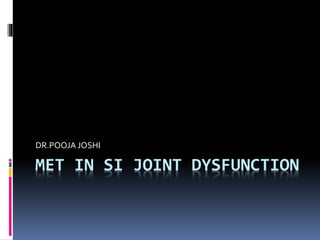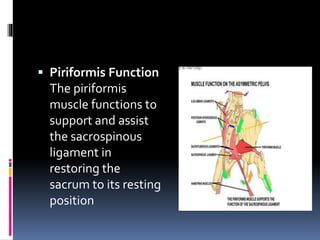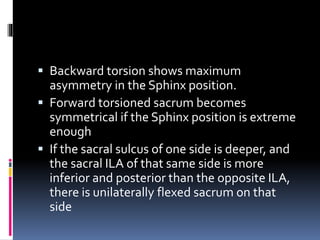Met in si joint dysfunction
- 1. MET IN SI JOINT DYSFUNCTION DR.POOJA JOSHI
- 3.  Piriformis Function The piriformis muscle functions to support and assist the sacrospinous ligament in restoring the sacrum to its resting position
- 4.  The sacral origin of the gluteus maximus serves to assist and support the function of the sacrotuberous ligament in bringing the distal sacrum anteriorly and laterally
- 5. ASSESSMENT
- 6. TESTS FOR ILA POSITIONS 1.PRONELYING 2.SPHINX POSITION 3.HYPERSPHINX POSITION 4.STANDING
- 8. TEST FOR SACRAL SULCI
- 9.  Backward torsion shows maximum asymmetry in the Sphinx position.  Forward torsioned sacrum becomes symmetrical if the Sphinx position is extreme enough  If the sacral sulcus of one side is deeper, and the sacral ILA of that same side is more inferior and posterior than the opposite ILA, there is unilaterally flexed sacrum on that side
- 10.  If the deeper sulcus is on one side and the prominent ILA is on the other side, there is sacral torsion toward the prominent ILA side
- 11. Tests  1.forward flexion test  2. seated flexion test  3.supine SLR test  4.prone extension test
- 12.  1.forward flexion tests:  To test forward flexion, the patient stands weight equally distributed on both legs.  The examiner sits behind the patient and palpates both PSIS  The patient is asked to bend forward and symmetry of movement of the PSIS superiorly noted
- 15. MECHANICS OF SI JOINT
- 17. Sacrum torsioned left on the left oblique axis (Left-on- Left)  All left torsions should have a fifth lumbar rotated right and sidebent left  Sacrum rotated left  Side bend- right  sulcus – deeper on right  ILA – inferior on left
- 18. bony positions of a Left-on- Right backward torsioned sacrum.
- 19. bony positions of a Right-on- Left backward torsioned sacrum.
- 20.  The ILA and sulcus depth findings look the same in forward torsioned as in backward torsioned sacrum to the left  Without the sphinx test it is not possible to tell whether asymmetric landmark (ILA or sulcus) displacement is forward on one side or backward on the other.  Forward torsions straighten in the sphinx position and worsen with forward trunk bending. Backward torsions get worse in the sphinx position and straighten with forward trunk bending.
- 21. TREATMENT
- 22. 1.Treatment for unilaterally flexed sacrum  Loosed pack position-15 degree abduction  Medial rotation - opens up the posterior rim of the sacroiliac joint  creating an opportunity for the sacral base to move backward  a movement which spreads the posterior superior iliac spines.
- 23.  The index finger continues to palpate the sacral sulcus while the other hand applies a ventral springing pressure to the ILA on the side of the lesion with l-2 kilograms of force  varying the angle of pressure slightly until the sulcus palpation indicates that the direction of force is the direction of greatest freedom of sacral movement
- 24. Treatment of a Resistant Unilaterally Flexed Sacrum  loose-pack  internally rotated position by bending the knee to 90 degrees and moving the foot laterally  step-inhalation  have the patient hold the breath and isometrically externally rotate the femur against your unyielding resistance
- 25. Self Treatment for Recurrent Unilaterally Flexed Sacrum  The patient sits with the teet flat on the floor  knees shoulder width apart. After bending forward, attempting to get the elbows between the feet  the patient takes 3 deep breaths. After each breath is exhaled completely the patient attempts to increase the flexion  This attempt may be helped by pulling on the chair legs with the hands
- 26. Treatment for Sacral Torsion Dysfunction  1.forward  2.backward
- 27. Procedure Protocol for Treatment of the Forward Torsioned Sacrum (Left-on-Left)  The hips and knees are flexed to 90 degrees.  The knees are together and about 6 inches ( 15 Cm.) beyond the edge of the table.  The trunk is rotated so that the chest approximates the table surface.  The arm lying upward hangs over the table edge; the other arm rests on the table behind the back.
- 28.  Operator holds the patient's right shoulder forward, maintaining trunk left rotation, and lowers the patient's feet several inches, usually below table level  This has the effect of externally rotating the right (top) thigh and internally rotating the left.
- 29.  This has the effect of externally rotating the right (top) thigh and internally rotating the left.  Hold the feet at the comfortable limit of thigh rotations, and ask the patient to push the feet up against your unyielding resistance (toward the ceiling)
- 30. forward torsioned sacral dysfunction with the therapist seated position  useful tor treating the larger, older, or obese patient because it provides better support for the patient's legs.
- 31.  The patient sits on a firm chair or low stool with the feet on the floor, ankles and knees together.  Ask the patient to "slump”  The patient puts both hands to the side of the lap.  corresponding to the side of the oblique axis. Say to the patient, "Breathe in and out and reach your forward hand toward the floor."  Use your hand to hold the shoulder back, preventing trunk flexion.
- 32. Treatment Techniques for Backward Torsioned Sacrum  a patient having a "Left-on- Right" (lett torsion of the right oblique axis) lesion  would lie on the right side.  With your other hand move the bottom leg posteriorly, hyperextending that hip until movement is felt at the lumbosacral junction.  The leg will remain in this extended position throughout the rest of the procedure.You may remove your hand from the leg.
- 33.  Maintaining trunk rotation, and pelvic alignment, bring the patient's top foot off the table by straightening the knee without flexing the hip.  Maintaining pelvic alignment, place your hand which has been palpating the lumbo-sacral junction on the foot, leg, or knee to resist abduction of the top leg
- 34.  Resist the abduction and move the leg out of the couch
- 36.  The patient lies on the noninvolved side, lesioned innominate up  The leg on the involved side is positioned by flexing the hip and knee of that side to about 90 degrees.  the patient attempt to adduct the femur against your unyielding resistance and then relax
- 38.  You resist the upward push of the knee with your hand on the lateral aspect of the knee instruct the patient to abduct the hip  hip flexion should be sufficiently increased to permit you to place your arm between the knee and the patient's ribs  Ask the patient to extend that hip as you resist the effort. "Push your foot against me."
- 39.  The patient is prone, lying close to the edge on your side of the table, and should be able to hang the leg down off the table.  The knee of the hanging leg is flexed to approximately 90 degrees, so that the foot can be placed on your nearer knee  patient attempt to extend that hip as you resist the effort. "Push your foot back against me
- 40. "Hard Way Shoe Tie"  Put your right foot on a chair or low stool.  Try to "tie your left shoe laces" with your left knee straight.  The patient stands with the right foot in the seat of a chair, and then reaches both hands toward the left foot.  Staying in this maximum flexed position
- 41. TREATMENT OF POSTERIOR INNOMINATE  The patient is prone, preferably on a very low table  You stand at the side of the table opposite to the lesion.  Your hand grasps the anterior aspect of the knee on the side to be treated
- 42.  with the thenar eminence contacting the posterior iliac crest on its most superior lateral aspect  Lift the leg, extending the hip, by keeping your elbow straight and leaning your body toward the head of the table.  If the knee bends, ask the patient to relax the leg and let the weight of the foot keep the knee straight.  Maintaining the extended position described above, have the patient attempt to flex that hip, as you resist the effort
- 43.  The top leg is extended and slightly abducted at the hip  so that it clears the other lower extremity.This is best accomplished by supporting the flexed knee with your hand and arm and stepping back.  Maintaining the position have the patient attempt to flex the hip as you resist the effort.  Have the patient relax. "Pull your knee forward."
- 44. REFERENCES :  Greenman, P.E.,Principle of mannual medicine.  Fred l mitcheel , JR.p.kai galen mitcheel,the muscle energy mannual  Leon chaitow, muscle energy technique,churchill livingstone











































